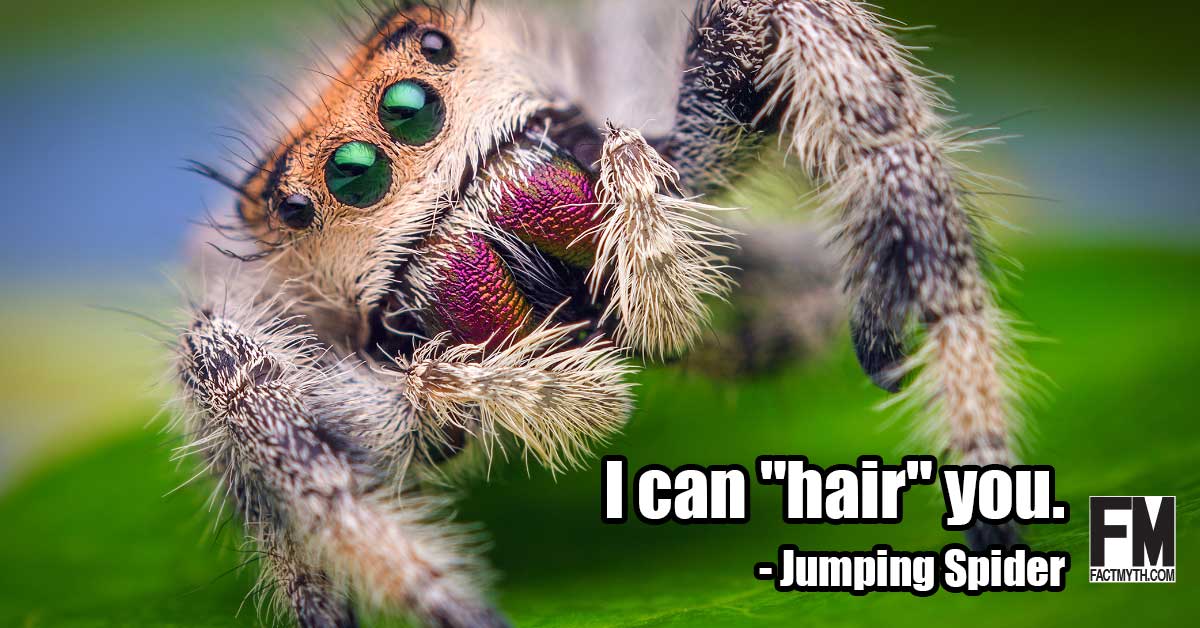If we define hearing loosely, then all spiders can hear via the hairs on their bodies. If we define hearing as processing auditory data via vibrations in air molecules, then we can say we know for sure at least the jumping spider can hear. If we are very strict and say hearing only occurs when an ear drum is used to process auditory data, then an argument can be made that spiders can’t hear. All that said, one can easily make the claim “spiders can hear” and be correct.
Spiders Hear Through Hairs on their Body fact

Can Spiders Hear? How Do Spiders Hear?
Although the specifics may be different for different spiders, spiders “hear” (sense vibrations) through hairs and tiny slits distributed over their body. Spiders can use this sensory skill to detect what type of prey falls into their web. They detect vibrations in the web to recognize their prey. Some spiders, like the jumping spider, have been shown to hear sounds in the air allowing them to, for instance, hear an incoming wasp.[1][2]
This may seem strange, but it isn’t much different than how humans hear. As humans, we have tiny hair cells in our ears which help us pick up sound waves (vibrations in air molecules). The hair cells then work with our ear drums and other parts of our complex auditory system to translate those vibrations into sensory data that can be processed in the auditory centers of our brain.
A spider works much the same way, except they don’t have eardrums, have little hairs covering most of their bodies, and process vibrations using their unique sensory system.
TIP: Learn more about how the senses work.
Even without ears, jumping spiders can hear you. Spiders have excellent eyesight and can detect vibrations, but despite their lack of ear drums, some spiders can actually “hear” too. In the jumping spider specifically, it has been shown that the auditory areas of a jumping spider’s brain can receive signals from its tiny hairs. So it isn’t just the tactical sensing of vibrations in solid objects they are picking up, they are processing auditory data from vibrations in air molecules.Can All Spiders Hear This Way?
All spiders can sense vibrations, but it is currently unknown if all spiders can “hear” vibrations in the air and processes that data in auditory centers of the brain.
According to a 2016 study, the jumping spider (which is fairly hairy, see the image above) can sense sounds up to 3 meters away through the air.
It is possible other spiders rely more on direct tactioception (sensing vibrations through direct contact with objects like their webbing).
Still, if the jumping spider can hear you from across the room via their hair, it only makes sense that other spiders can also hear this way.[3]
Learn more about “spider senses” from the Smithsonian.
Unlike Other Spiders, Jumping Spiders Can Hear.FACT: As noted in the video above, spiders cannot hear like humans do. They do not have eardrums and instead use the hair on their legs to feel vibrations. However, Jumping spiders seem to be able to hear not only through vibrations in their webs or solid surfaces; they also have the capability of hearing sounds through the air up to 3 meters away. Scientists learned this by watching a jumping spider’s brain use auditory nerve cells. This is an impressive finding when we consider that a jumping spider’s brain is about the same size a poppy seed.[4]
Do Spiders Have Ears? Spiders don’t have ears, but they can “hear.” They use the little hairs over their bodies to detect vibrations, which is essentially “hearing.” As this video shows, the spider is “hearing” through its web (if not hearing an instrument like the saxophone directly) as the saxophone is vibrating the air, which is vibrating the web, and we can see the spider reacting.